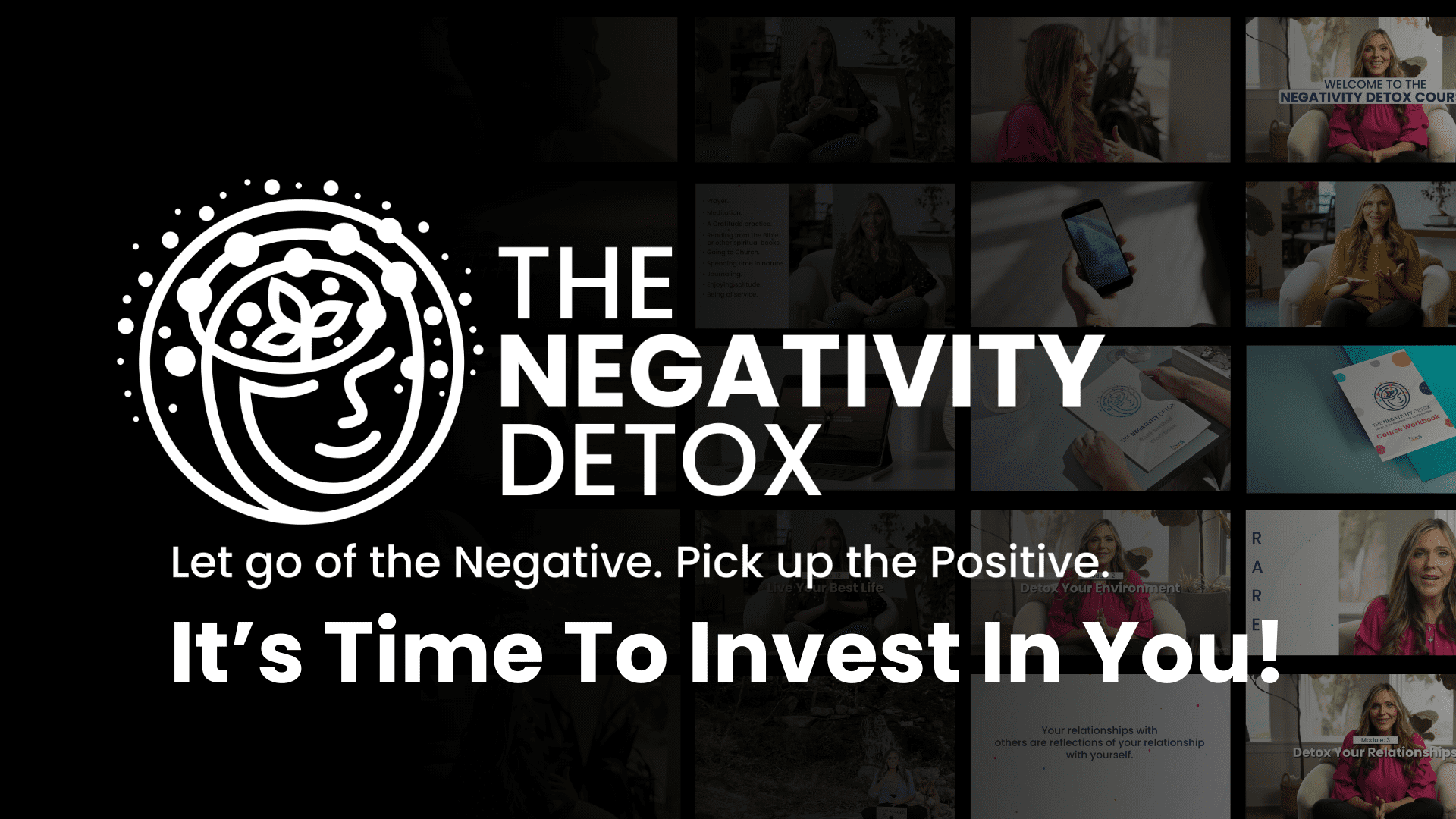Here’s how to clear negativity out of your life.
Are you struggling with a negative mindset? It’s essential to release that negativity to find success and happiness.
But here’s a little-known gem – you are not alone.
Indeed, the mind plays a pivotal role as both the architect and the interpreter. Our mindset, a culmination of beliefs, attitudes, and thoughts, serves as the compass directing our actions, molding our reactions, and shaping our overall well-being.
Mental clarity isn’t just a luxury in today’s world, characterized by its breakneck pace and relentless demands. Instead, it is a necessity. Relationships, whether with colleagues, family, or friends, can act as both sanctuaries and sources of stress, making maintaining a positive mental state even more crucial.
Four Key Benefits of a Positive Mindset
Here are reasons to leave your negative mindset behind:

- Enhanced Health: A positive mindset is akin to a protective barrier, shielding the body from the damaging effects of stress. Research has consistently shown that individuals with a sunnier disposition have reduced cortisol (a stress hormone), lowered blood pressure, and decreased chronic disease risks. They tend to engage in healthier habits. That might come from their optimistic outlook, further amplifying their health benefits.
- Improved Relationships: Have you ever noticed how some people draw others towards them magnetically? Optimism and positivity are often at the root. A positive outlook fosters understanding, compassion, and empathy, all essential to building solid and meaningful connections. When challenges arise, as they inevitably do, those armed with optimism are more likely to approach them constructively, nurturing rather than damaging their relationships.
- Increased Productivity: At the workplace and in personal projects, a positive mindset can be the wind beneath your wings. An optimistic outlook can heighten creativity, boost problem-solving skills, and encourage resilience in the face of setbacks. When you believe that good outcomes are possible and likely, you’re more inclined to push through barriers and achieve your goals.
- Better Coping Mechanisms: Life is a mosaic of highs and lows. While we can’t always control the challenges that come our way, we can determine our response. A positive mindset doesn’t just offer rose-tinted glasses to view the world; it equips individuals with the tools to navigate life’s storms with grace and grit.
The Harmful Nature of Carrying Negativity
- Physical Health Impacts: Like a slow-acting poison, prolonged negativity can erode our health. Constant stress and negative thinking can increase the risk of heart disease, weaken the immune system, and even impair cognitive functions. Negative thinkers often fall into unhealthy coping patterns like smoking, excessive alcohol consumption, or overeating, exacerbating health risks.
- Relationship Strains: Just as positivity can draw people in, sustained negativity can push them away. Negative individuals often exude an energy of criticism, pessimism, and discontent, making interactions draining and challenging. Over time, this can lead to conflicts, misunderstandings, and ultimately, isolation from loved ones.
- Stunted Personal Growth: A negative mindset is like an anchor, holding one back from exploring new horizons. It breeds fear of failure, stifles creativity, and clouds judgment. Growth opportunities, both personal and professional, might be overlooked or avoided entirely due to a fear of inadequacy or potential setbacks.
- Reduced Lifespan: Consider this if the points above didn’t offer enough reasons to combat negativity. Studies show chronic negativity and pessimism can lead to stress, lowering life expectancy. It’s a sobering realization, highlighting the intricate interplay between mind, body, and longevity.
10 Ways to Overcome a Negative Mindset
Each solution presented below is not just a standalone strategy but a step in a journey. As with any journey, patience, persistence, and consistency are paramount. Integrating these practices into daily life can sow the seeds for a more positive, fulfilling existence.
1. Practice Mindfulness and Meditation
The human brain, impressive as it is, often functions like a runaway train, especially when burdened with negativity. Mindfulness and meditation offer a way to take control of that train gently, guiding it purposefully instead of letting it run amok.
What is mindfulness?
At its core, mindfulness means staying present—fully engaged in the moment, without judgment. It’s the conscious act of anchoring oneself to the current experience, whether it’s the taste of your morning coffee or the sensation of a breeze against your skin.
How meditation helps:
Meditation can be considered a gym session for the mind. One can cultivate an enhanced capacity to remain present by setting aside dedicated time for mindfulness. They might also reduce stress and tackle negative thoughts. Over time and with consistent practice, meditation can rewire the brain. Studies prove how regular meditators have more gray matter in brain parts linked to emotional regulation and response control.
Starting the practice:
For beginners, the idea of meditation might seem daunting. But one doesn’t need to start with hour-long sessions. Just a few minutes a day, focusing on your breath, or using guided meditations available on numerous apps can be a game-changer.
2. Journaling to Release a Negative Mindset
There’s profound power in translating thoughts into words. Journaling can be a grounding force when a negative mindset is a whirlwind of negativity. In fact, writing helps one discern patterns, identify triggers, and find clarity.
Benefits:
Journaling encourages reflection. It provides a non-judgmental space to vent, understand, and process emotions. Over time, you might notice patterns. For instance, you might note specific events or individuals frequently triggering negative thoughts. Recognizing these patterns is the first step toward addressing and overcoming them.
Tips for effective journaling:
While there’s no right way to journal, here are a few tips to get the most from this practice:
- Consistency is key: Make journal writing a daily habit, even if it’s just a few lines.
- Go beyond events: Dig into feelings, reactions, and reflections.
- Date your entries: It helps track progress and reflect on growth over time.
- Stay honest: The journal is a personal space; there’s no need for filters or pretense.
Need help to get started? Check out the 3-Minute Positivity Journal – you’ll receive encouragement and guidance on every page!
3. Seek Professional Help
There remains, unfortunately, a lingering stigma around seeking therapy or counseling. However, just as one would consult a doctor for physical ailments, a therapist can offer expert guidance for emotional and mental challenges.
Why it’s essential:
Therapists offer insights and coping strategies. They also provide tools tailored to individual needs. They also provide a safe space to explore feelings, confront traumas, and develop resilience.
When to seek help:
If negative thoughts become overwhelming, persistent, or lead to behaviors that impact daily life, it’s time to consult a professional. However, one needn’t wait for a crisis. Therapy can be beneficial even if you’re looking for personal growth or understanding.
Finding the right therapist:
It’s critical to find someone you trust and feel comfortable with. Recommendations from friends or primary care physicians, checking online platforms, and initial consultation sessions can guide you in making the right choice.

4. Limit Exposure to Negative Influences
We face constant exposure to various stimuli, not all of which serve our mental well-being. Recognizing and distancing ourselves from negative influences can significantly affect our mindset.
Sources of Your Negative Mindset:
These can range from the obvious, like pessimistic individuals or traumatic news broadcasts, to the subtle, such as social media platforms rife with unrealistic portrayals of ‘perfect’ lives.
Impact on Mindset:
Constant exposure to negativity, whether from media or personal connections, can skew our perception of reality, amplify feelings of inadequacy, and diminish our capacity for joy and contentment.
Strategies to Limit Exposure:
- Curate Your Media Intake: Limiting the time spent on news sites or social platforms. Instead, choose uplifting content. Also, unfollowing harmful sources can significantly reduce daily stress.
- Evaluate Relationships: Surrounding oneself with optimistic and supportive individuals can boost morale. Conversely, consider reducing time spent with constant pessimists or critics.
- Seek Positive Spaces: Engage in online or offline communities that align with your values and foster positivity.
5. Challenge Your Negative Mindset
The human mind is a storyteller. In fact, it often spins narratives that aren’t fact-based. Challenging and reframing these stories can drastically alter our mindset.
Cognitive Behavioral Therapy (CBT):
A prominent form of therapy, CBT, involves identifying negative thought patterns and consciously challenging and replacing them. It hinges on the belief that our thoughts shape our actions and emotions.
Techniques:
- Thought Stopping: When a negative thought arises, mentally yell, “Stop!” This word breaks the cycle and creates space to introduce a positive counter-thought.
- Fact-checking: Evaluate the truth behind a negative thought. Is it based on fact or assumption? Often, we’ll find our minds jump to worst-case scenarios without evidence.
- Positive Reframing: Focus on finding a silver lining or an alternative positive perspective to a negative situation.
Practice Makes Perfect:
Like any skill, consistently challenging negative thoughts can make this process second nature, ensuring a more balanced and positive mindset.
6. Focus on Gratitude:
Amid challenges and setbacks, it’s easy to lose sight of the blessings in our lives. Cultivating a daily gratitude practice can shift our focus from what’s lacking or wrong. In contrast, it helps us determine what’s abundant and suitable in our lives.
The Psychology Behind Gratitude:
Studies have shown that focusing on gratitude releases dopamine and serotonin, two crucial neurotransmitters responsible for our emotions. They enhance our mood immediately, making us feel happier from the inside out.
Ways to Cultivate Gratitude:
- Gratitude Journal: Dedicate daily moments to list things you’re grateful for. It could be as significant as a supportive family or as simple as a delicious meal.
- Gratitude Jar: Write down positive events or things you’re thankful for on slips of paper and place them in a jar. Read a few for an instant mood boost whenever you feel down.
- Express Yourself: Regularly tell loved ones you appreciate them. Not only does this make you feel good, but it also strengthens bonds.
7. Engage in Physical Activity
The connection between the body and the mind is profound. Physical activity isn’t just a catalyst for physical health. Instead, studies suggest how it links to our mental well-being.
Why Exercise Matters:
Engaging in physical activity releases endorphins – the body’s natural mood elevators. Exercise may alleviate symptoms of depression and anxiety. Indeed, even short bursts of movement can lead to a reduction in negative thoughts.
Activities to Consider:
- Aerobic Exercises: Running, cycling, or swimming may reduce anxiety and depression.
- Yog: Beyond the physical stretch, yoga emphasizes mindfulness and deep breathing. As a result, it aligns the mind and body.
- Dancing: A fun way to lift spirits, dancing combines movement with music, both of which can elevate mood.
- Nature Walks: Immersion in nature can reduce rumination or overthinking.
8. Establish Healthy Boundaries
In the quest to cater to everyone, we often sideline our needs. Conversely, establishing boundaries is an act of self-respect. In fact, it ensures that external demands don’t drain our mental energy.
The Importance of Boundaries:
Boundaries act as a protective shield, safeguarding our emotional and mental health. They help define what we find acceptable and what we don’t, preventing feeling overwhelmed or taken advantage of.
Steps to Set Boundaries:
- Self-awareness: Recognize what drains you emotionally. Is it constantly being available for others? Or engaging in specific types of conversations? (That’s for you to decide!)
- Communicate Clearly: Express your limits kindly but firmly. For instance, if you’re trying to reduce negativity, let loved ones know you’d like to avoid specific topics.
- Prioritize Self-Care: Remember, saying “no” or taking time for yourself is okay. Therefore, taking breaks from technology, work, or social interactions can heal your soul.
9. Cultivate a Growth Mindset to Offset a Negative Mindset
Introduced by psychologist Dr. Carol Dweck, the concept of a growth mindset revolves around the belief that abilities and intelligence develop with time and effort.
Fixed vs. Growth Mindset:
Individuals with a fixed mindset believe their capabilities are static and unchangeable. On the other hand, those with a growth mindset view challenges as opportunities to grow. As a result, they learn from failures and continually evolve.
Benefits of a Growth Mindset:
- Enhanced Resilience: Seeing setbacks as learning opportunities rather than failures fosters resilience, ensuring you bounce back quicker.
- Continuous Learning: With a growth mindset, an ongoing desire to learn and improve leads to personal and professional development.
- Positive Outlook: Challenges are seen positively as stepping stones rather than insurmountable obstacles.
Developing a Growth Mindset:
- Embrace Challenges: Expand your comfort zone regularly. It’s in facing challenges that we grow the most.
- Learn from Feedback: Constructive criticism isn’t an attack but an opportunity to learn and evolve.
- Celebrate Small Wins: Recognize and celebrate progress, no matter how minor it seems.
10. Foster Social Connections
Humans are inherently social beings. The bonds we form, the connections we nurture, and the communities we become part of play a pivotal role in our mental and emotional well-being.
The Power of Connection:
Isolation can breed negativity, while social connections can buffer against depression, anxiety, and stress. Therefore, sharing our worries, laughing over little joys, or merely being in the presence of loved ones can provide a sense of belonging and purpose.
How to Build and Strengthen Connections:
- Active Listening: Engage in conversations where you truly listen without preparing a response in your mind. This habit deepens bonds and enhances understanding.
- Join Interest Groups: Participate in clubs or groups that align with your hobbies or passions, allowing you to connect with like-minded individuals.
- Volunteer: Acts of kindness and giving back not only elevate your mood but also help build connections within the community.
- Limit Digital Distractions: While technology has its merits. However, face-to-face interactions have an irreplaceable warmth and depth. Prioritize real-world connections over digital ones whenever possible.

Final Thoughts on Beating a Negative Mindset
Navigating the complexities of the human mind is no small feat. Sometimes, negativity can seem overwhelming, casting a shadow over every facet of life. However, remember that the power to shift from a negative to a positive mindset primarily resides within you.
Each strategy outlined above is a stepping stone on the path to positivity. While some may resonate more than others, the key lies in persistence, patience, and a genuine commitment to change.
Furthermore, it’s vital to remember that everyone has their unique journey. Comparisons, especially in an era dominated by curated social media highlights, ensnare your mind. Your journey, with its highs and lows, triumphs and setbacks, is uniquely yours. For that reason alone, it deserves celebration.
Lastly, while these tools and strategies are practical, extending kindness to oneself is essential. Change doesn’t happen overnight. There will be days when negativity might rear its head again. But with these tools and a commitment to growth, you will better deal with it, challenge it, and ultimately transform it.
So here’s to a brighter, more positive outlook on life, where you release that negative mindset. Shine on!
The post 10 Ways to Beat a Negative Mindset appeared first on Power of Positivity: Positive Thinking & Attitude.







